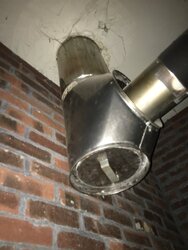There is a 25 foot 6” stainless steel liner that is inside of another larger pipe. In a previous post you saw a picture and referred to it as “class A chimney” I believe.What type of chimney is this running through?
I’ve attached the pic again. If I remove that cap and look up I can see the stainless steel liner inside the larger chimney pipe. I looked up there yesterday and the liner looked quite clean to me, almost nothing coating inside.

Last edited by a moderator:

